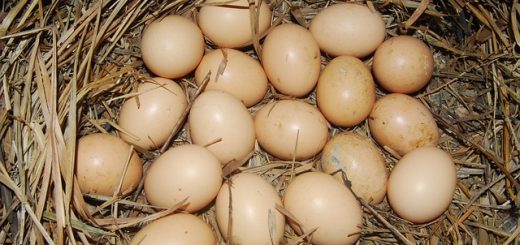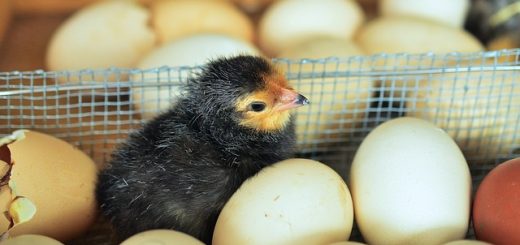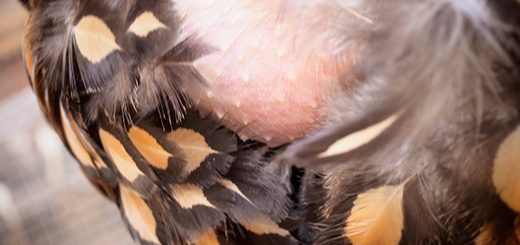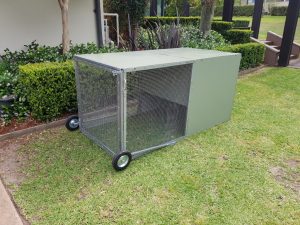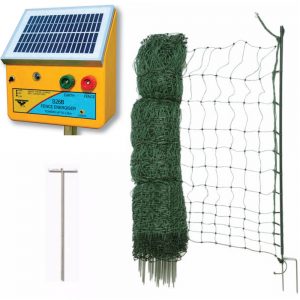Guide to Backyard Chickens & How to Raise Chickens
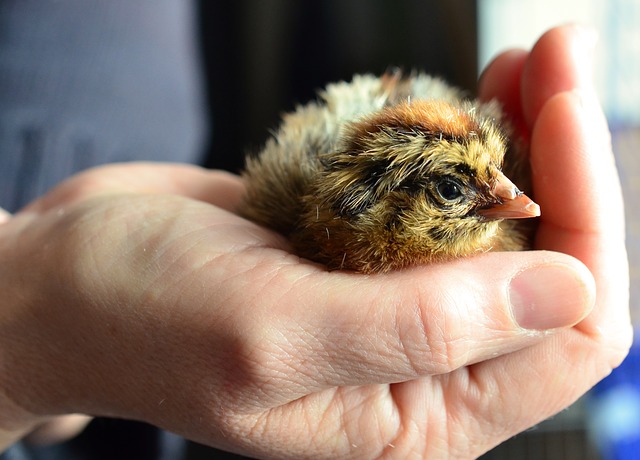
Keeping backyard chickens is an easy first step to living a healthier, more sustainable lifestyle. Compared to keeping other livestock, raising chickens is easy. They come home every night, lay eggs faithfully, can eat a diverse range of foods and are highly adaptable. And don’t forget the best part: they produce delicious eggs. Once you’ve tasted backyard chicken eggs you won’t go back to commercial eggs.
This article will teach you how to raise chickens at home. Learn about chicken coops, breeds, diet, raising chicks and more. Everything you need to know to get your flock started is right here.
Am I Allowed to Raise Chickens
The first step in learning how to raise chickens is to make sure that you can legally keep them. Many cities and towns have specific ordinances regarding chickens, and some counties have regulations as well. Some don’t allow you to raise backyard chickens at all, while others set limits on the size of the flock permitted, or ban keeping roosters. This is a good resource for looking up local ordinances regarding backyard chickens. If your town doesn’t appear on the list, try a simple google search.
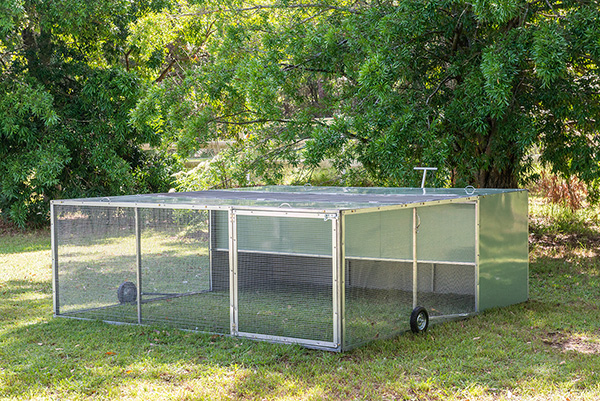
McCallum Made Chicken Tractors are mobile and strong, and wether-proof
Our mobile chicken coop partner with it canvass cover is suitable fro your poultry and small animals during the winter.
Choose and Buy our Chicken Tractors and Coops.
Choose Chicken Tractors Cover
RELATED: Tips for Keeping Urban Chickens
Of course, many people raise backyard chickens despite town or county laws prohibiting it. Maintaining good relationships with your neighbors is the key to success you intend to join the ranks of those raising chickens “underground”. Typically the laws prohibiting raising chickens are not strictly enforced unless someone complains. Don’t keep a rooster, keep your chicken coop clean to minimize the smell, make sure your fencing stays in good condition and you should be in good shape.
Raising Chickens for Eggs and More
The most common reason for keeping backyard chickens is to get fresh, organic eggs. Once you’ve seen the deep golden yolk and taste the rich flavor of a backyard egg, you’ll never want to eat the store-bought variety again.
Of course, there are many other reasons for raising chickens:
- Backyard Chickens are Master Composters – A hen is an expert at working compost. She will root it up, turn it over and add nitrogen-rich fertilizer to it. Allowing your backyard chickens into your compost pile will also reduce your feed costs as they consume high protein bugs, grubs, and left-overs.
- Chicken Insect Control – Your backyard chickens will happily manage any fly problems you have. They are great at reducing the gnats around a manure pile and can be allowed into a mature garden to remove pests. Keep backyard chickens away from seedlings, strawberries or any tender greens. They like them as much as we do.
- Tasty, Organic Meat – Raising chickens for meat is a rewarding way to produce your own high-quality protein. You can choose to raise fast-growing meat breeds, or you can eat any culled hens or even surplus young roosters if you breed your own.
- Garden Builder – You can turn your hens out on an area that you want to turn into a garden. They will eat the weeds, till the earth and fertilize all at once. And chickens are the best way to get rid of grass in a future garden bed.
- Entertainment – Backyard chickens are a joy to have around. They are funny, social creatures. You will get to know their individual personalities and start to look forward to watching their daily dust baths. When they come running for breakfast you’ll be hard pressed not to laugh.
How Many Chickens Do I Need?
When you start out raising chickens for the first time, you have to consider how many you should start with. The answer depends on several factors:
- How Many Eggs Do You Need?
The number of eggs each hen lays varies by breed and individual. After a hen lays an egg her body starts working on the next one. It usually takes at least 26 hours for the egg to form, so the hen will not lay at the same time each day and sometimes she’ll skip a day. If you’re new to raising chickens, don’t forget that hens will take a couple of months off during the winter, when they will molt (lose and grow new feathers) and rest.During the laying season, which can be up to 10 months a year, most will lay 4-6 eggs a week. For more specific information, check out our page on the top chicken breeds for egg production. Happy hens lay more eggs. You will get more eggs from backyard chickens if you give them a little space to roam and scratch in the dirt. - How Much Space Do You Have?
Don’t start raising chickens that you don’t have room to the house. Raising chickens in a cramped space can lead to illness or injury. Stressed out hens lay fewer eggs. The size of the coop will vary depending on whether or not your birds will be allowed to range freely. Birds that are pastured or always have access to a large outside area only need enough room to roost and lay eggs. Most backyard chickens don’t have access to that much space.Backyard chickens that live in a coop with a run should have at least three square feet of space inside per bird, plus about 18 square feet of space in the run. If you started out with six backyard chickens, you should have an 18 square foot coop (say 6’X 3′) and 110 square foot run (10’X 11′). These are minimum numbers. If you can provide more space per bird, do it. You will have fewer health problems and better egg production from a small flock with lots of space than from a large crowded one. - Will You Keep a Rooster?
Many people like to keep a rooster when raising chickens. In addition to allowing you to breed chickens naturally, he will also protect the hens as best he can and watch over them while they lay their eggs. He will fertilize the eggs, so If you have a broody hen you can let her raise chicks, or hatch the eggs yourself using an incubator. Roosters are also especially beautiful birds. Don’t forget about the crowing. They actually start an hour or so before dawn, so you may want to situate the coop a good distance from the house.Many people keep a rooster with one or two hens, but this can lead to over-breeding, especially if they are confined as most backyard chickens are. Over-bred hens lose feathers on their back and wings and are tired. The stress can reduce their egg production. For a healthy flock, you should have 6-12 hens if you intend to keep a rooster
The Perfect Backyard Chicken Coop
Once you’ve decided how many backyard chickens you need, you’re ready to build or buy a coop. A simple chicken coop can be built out of nearly anything: leftover building materials, 55-gallon drums, PVC pipe, chicken wire, and roofing scraps. Whether you build or buy a coop, it should have the following features:
- Perches – If they are allowed to range your backyard chickens will come home to the coop just before dark and seek a high branch to sleep on. Provide 8-10 inches of roosting space per hen and about 18 inches for roosters. Remember to leave 18-24 inches of head space above the perches so they have room to fly up. If your coop design allows it, place several perches up high. All your chickens will want to roost on the highest perch and dominant birds may fight if space is limited.
- Nest Boxes – You are likely raising chickens for eggs, so a good nest box is essential. It can be a basket on its side, an egg crate or a simple wooden box. Remember that chickens looking for a secluded, safe place to lay their eggs. Provide one nest box for every three hens to avoid crowding.
- Solid Structure – Backyard chickens can tolerate hot summers and frigid winters as long as they are protected from the wind and the wet and have ample shade. In the most extreme cold weather roosters may suffer frostbite on their combs or wattles, as they don’t tuck their heads under their wings as hens do. But if the coop stays dry and not drafty, they will be fine.
- Predator Proof – You put a lot of work into raising chickens. Don’t let predators steal your eggs. Foxes, skunks, large hawks, stray dogs and weasels all like the taste of chicken and eggs. Even sweet pet dogs may surprise you with their taste for fresh eggs. The entrance to the coop should be up high, with a ramp for the chickens to climb. This will deter many predators. A rooster, goose or a livestock guardian animal will stop the rest.
If your chickens will spend all their time in the coop it should be quite large, at least five or six square feet per bird. They will be happier and healthier if they are allowed outside, even in a small run. It is natural for chickens to scratch and bathes in the dirt.
RELATED: How to Raise Chickens for Eggs Ethically
Some backyard chickens spend part of their time closed in the coop and part of it roaming. If your hens will be unable to access the coop during parts of the day, make sure there is plenty of shade in their run. They love to nap under the bushes.
Chicken Coops for Sale
There are many companies which build chicken coops designed for backyard chickens. Here a few of our favorites:
- Wayfair Coops for Backyard Chickens
- Chicken Coops and Chicken Coop Designs, Including Bear-Resistant Coop Plans
- Sturdy Chicken Coops for Every Yard
These are big companies. If you can find a smaller coop builder in your community that’s even better. You’ll save on shipping and support a local business. A local provider may also be willing to design a custom coop to suit your exact needs. Or, if you are handy with a hammer and nails, you can build a home for your backyard chickens all on your own. Learn all about building a cheap urban chicken coop here.

Image courtesy of pinterest.com
Backyard Chicken Breeds
To help you understand how to raise chickens properly you should have a basic knowledge of their evolutionary history. Common backyard chickens of all breeds descended from the jungle fowl, a wild species which still exists in Sri Lanka and India. This forest bird has first domesticated in Asia about 5000 years ago. They roost in trees unless the females have a clutch of chicks in which case they build a hidden nest on the jungle floor. During the day they come down to forage for insects, fruit, flowers, and seeds. The males are spectacular in appearance, and their crow is just like that of a domestic rooster.
The female jungle fowl is an impressive mother. This is one of the traits that has been bred out of most domestic chickens. From this skittish wild bird, humans have bred a wide variety of chicken breeds with different specialties. They fall into four general groups: egg-laying breeds, meat breeds, dual-purpose breeds, and heritage breeds. While there are 65 chicken breeds recognized by the American Poultry Association and hundreds of breeds worldwide, not all are suited to the beginner.
Here are some of the best backyard chicken breeds to start with as you’re learning how to raise chickens.
- Egg Chickens
When it comes to raising chickens for eggs you have a lot of options as far as breeds are concerned. There is one important definition you should understand: what is a hybrid chicken breed? A hybrid is a cross of two pure breeds. There are several hybrid strains you can choose from. The hens usually lay more eggs than pure breeds and mature at a younger age.For instance, many breeds take more than six months to mature and start laying, while many hybrids start after only 17 weeks. The downside to raising chickens that are hybrids is that you can’t really breed them on your own. They will produce fertile eggs if there is a rooster, but the offspring will be unpredictable. Their chicks may not be great egg layers like their mothers.There are some fast maturing heritage breeds that lay beautiful eggs. Red Caps, White-faced Black Spanish, Anconas, and Minorca chickens all start laying in about 21 weeks. They won’t produce as many eggs as a hybrid hen, but you will be helping to preserve an endangered line. And you’ll be able to breed your backyard chickens if you choose.
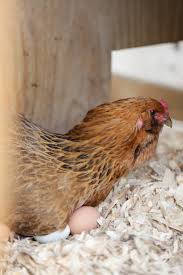
Image courtesy of backyardchickens.com
- Here are some of the top chicken breeds for egg production.
- Ameracaunas – Part of the fun of keeping backyard chickens is watching them. Raising chickens that are unique in appearance can be a lot of fun. The Ameracaunas have distinctive fluffy feathers around their head, which make them unique additions to the flock. Each hen will lay about 200 beautifully colored eggs ranging from blue to olive green to a pale lavender each year.
- Goldline – This hybrid is an egg-laying machine. The small brown hens can lay 320 large brown eggs each year. They are exceptionally friendly and curious birds. Goldlines are a great choice as you’re learning how to raise chickens. They will make it fun for you!
- Marans – Raising chickens from a heritage breed is especially rewarding. These hens lay gorgeous dark brown eggs. Expect 200 eggs a year. Marans are one of the few breeds that lay well during the winter months. Pullets (young hens) often start laying in January. Adding a few Marans to your flock to get eggs in the months most backyard chickens stop laying.
- For more information on laying breeds check out our article on the top chicken breeds for egg production.
- Meat Chickens
If you are raising chickens for meat you want broilers. These are fast-growing breeds which usually produce a lot of breast meat. Broilers have a high feed conversion rate and can dress out at four pounds at just seven weeks of age. The Cornish Cross is the main broiler breed in the States. Pure meat breeds are the best for backyard chickens. They have been bred to suit the commercial industry, and most homesteaders choose a dual-purpose breed instead.- Cornish Cross – A fast-growing broiler, the Cornish Cross yields about four pounds of meat in seven to eight weeks. They have large, wide breasts, big legs, and heavy thighs. Nearly all commercial operations raising chickens for meat grow Cornish Crosses. They are so efficient at turning feed into meat and fat that they are prone to obesity if kept more than two months. To survive more than a few months they need a restricted diet.
- Dual-Purpose Breeds
If you’re just starting out raising chickens you’ll probably want a dual-purpose breed. The hens produce plenty of quality eggs, and the birds are meaty enough to make a nice soup or roast. Even if you are raising chickens for eggs only, at some point you may have to cull a hen with laying problems or find yourself with extra roosters. It is nice if the culled birds can make a decent meal.- Jersey Giant – As the name suggests, these are big birds. They were originally bred as an alternative to the turkey. Their large size means they grow a bit slower, reaching a dressed weight of 11-13 pounds in six months. They were originally bred as meat birds, but they also lay extra large brown eggs and make great backyard chickens. Coupled with their slower growth rate, their egg production has made them more desirable as a dual-purpose breed. If you are interested in raising chickens for meat, give the Jersey Giant a try.
- Plymouth Rock – There are several varieties of this breed, including the White and the Barred Plymouth Rock. They are all docile and friendly, making them perfect backyard chickens for the beginner. They can grow quite large, reaching nearly ten pounds, and they lay large brown eggs.
- Delaware – Many people raising chickens for meat in the 1950’s raised this heritage breed. They are a pleasant breed. The hens especially tend to be very sweet and have pretty fluffy feathers. With their kind temperament and medium-sized light brown eggs, they make a great dual purpose breed for anyone who wants to get started raising chickens.
- Heritage Breeds
Raising chickens from heritage breeds is important to preserve these rare lines. A heritage breed is a line of chickens that is endangered. Additionally, a heritage breed must: breed naturally (without artificial insemination), live a long productive life (5-7 years for a laying hen) and have a slow growth rate (this allows them to develop strong, healthy skeletons and immune systems). Heritage breeds are usually tougher than other breeds making them ideal backyard chickens. They are endangered because they don’t mature as quickly or produce as much meat or eggs in a short time. However, a heritage hen will keep laying eggs for years to come, while many other breeds wear out after only two years.- Dorking – A tranquil bird that does well with the whole family, the Dorking is a great dual-purpose breed. Like the Maran, the hens lay well through the winter when other birds stop. The hens are also good brooders and make excellent mothers. They care for their chicks for a long time, ensuring their survival with little input from you. This is a great choice if you want to start breeding and raising chickens at home.
- Buckeye – This is a breed that does best if allowed to free-range. They are too active to remain confined for long periods of time. However, they are very cold hardy which makes them good backyard chickens in areas with harsh winters. They lay medium sized brown eggs, and roosters average nine pounds in weight.
- Speckled Sussex – Sussex hens are some of the nicest birds around. They are perfect backyard chickens, though if you’re not careful they’ll become house pets. They love the company of humans and are easy to handle. They are good layers of light brown eggs.
- Buff Orpington – These friendly birds may soon come off the endangered list, thanks to their growing popularity as backyard chickens. They are small hens who lay fewer eggs than many other breeds, but they are so darn friendly that they’ll win you over immediately. They are easy to care for, have gorgeous golden feathers and the nicest personality you could hope for.
RELATED: Why Everyone Needs a Silkie Chicken
Getting Started Raising Chickens
Whew. That was a lot of information. But now you’re ready for the fun part: getting started with your real, live backyard chickens! The most common ways to start raising chickens are to either buy day-old chicks or mature laying hens. There are pros and cons to both.
Benefits of Raising Chickens from Day Old Chicks: You get to socialize the babies from day one. Raising chickens this way makes the whole flock friendlier and easier to handle later on.
A downside to Raising Chickens from Day Old Chicks: You have to wait for them to grow up to get eggs. Most backyard chickens take between 17-26 weeks to mature.
Follow The Timeline for Raising Baby Chicks
Benefits of Raising Chickens from Day Old Chicks: Your hens are ready to go. Once they get settled you can expect eggs almost immediately.
Downside to Raising Chickens from Day Old Chicks: You won’t know much for certain about your hens. If someone is getting rid of a laying hen, there is usually a reason. She may have problems laying, be old, sick or just especially feisty. If you’re just starting out with backyard chickens, you don’t want to deal with these problems.
Because of the uncertainties that come with grown hens, most people will start out raising chickens from babies. Here’s what you need to know to get started:
How to Care for Baby Chicks
First, you need to get the chicks. There are many places to order day old chicks. Try to find a small breeder, a reputable heritage breeder or at least a large farm that discloses its methods for raising the birds. You want healthy chicks from healthy hens.
Your backyard chickens will arrive at the Post Office. That’s right. UPS, FedEx, and other shippers won’t transport live animals, but the Post Office will.
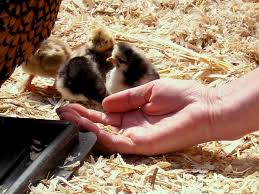
Image courtesy of chickenskeeping.co.uk
How do Chicks Survive Shipping
Mother nature knows how to raise chickens better than anyone. When a chick hatches the yolk sac provides all the nutrients it needs to survive the first two to three days. This is why you can usually only get day old chicks. They won’t need to eat until they arrive at your farm. But they’ll be ravenous soon!
A Brooder for Chicks
Baby chicks are delicate. The hardest part of raising chickens is keeping the babies healthy for the first three weeks. They should be placed in a brooder initially. This can be as simple as a cardboard box with a light bulb over it. You want the temperature to stay between 90-95°F the first week, then lower it by 5°F each week. At three weeks old they can start going outside in nice weather.
Feeding Chicks
Chicks need small bits of food they can pick up and digest. You can purchase chick starter or chick crumbles, or make your own by mixing corn flour, milk, eggs and a bit of oil into a thick paste. Even baby chickens like to scratch, so get a good heavy feeder they can’t topple. As with raising chickens of all ages, fresh water should be available at all times. After a week or two offer them coarse sand for grit. You can also start feeding bits of vegetable and kitchen scraps sparingly at this point.
Keeping Chicks Healthy
The most common problem chicks encounter is called “pasty butt”. Sticky feces form a seal around their anus and they can’t defecate. This condition can kill a chick, but it’s easy to fix. Just place a warm, wet paper towel over the chick’s bottom and soak the manure off. Adding a little raw apple cider vinegar to their water helps prevent pasty butt.
Raising chickens from babies is as often perceived as stressful undertaking. Don’t worry. Chicks will tell you what they need. They huddle together if they’re cold, and hang out far from the light when they are too hot. They will cheep loudly if hungry, cold or thirsty. And they are a lot tougher than they look. Even if you make a few mistakes, you will still end up with a great flock of backyard chickens.
Feeding Backyard Chickens
Once your chicks have grown their first set of feathers you can move them out to the coop. You have several options for feeding pullets (young hens) and adult backyard chickens. Rule number one for raising chickens: a balanced diet is essential for healthy birds and abundant eggs.
- Feed Commercial Rations – For the beginner learning how to raise chickens, this is the easiest option. You can choose organic feed if you like. Remember that laying hens need more nutrients and calcium than young birds and roosters. Choosing a laying ration or an all-flock feed is best for most backyard chickens.
- Homemade Feed – You can mix a quality chicken feed at home. You need to provide varied grains and proteins. Try Garden Betty’s Whole Grain Chicken Feed Recipe for backyard chickens.
- Forage – If your backyard chickens have room to range your feed costs will diminish significantly. Chickens will eat grass, weeds, and herbs, as well as scratch up worms, bugs and invertebrates. They love to root through a compost pile.
- Kitchen and Garden Scraps – Many people think you can feed backyard chickens solely on scraps from your kitchen or garden. But these foods should be seen as a supplement because they do not necessarily provide consistent nutrition that laying chickens need.
In addition, backyard chickens always need fresh water and a supply of grit. Laying hens, in particular, should have access to a calcium supplement that is separate from their feed. Crushed oyster shells are a great calcium source.
Learn how feeding herbs fight internal chicken parasites: Make a Natural Chicken Wormer.

One important equipment that every chicken keeper should have – Chicken Feeder and or Drinker
Dealing with Manure
A single hen produces one cubic foot of manure every six months. If you’ve never kept livestock before, the problem of manure may be overwhelming at first. In time you’ll come to see chicken manure for the valuable resource it is.
Chicken poop serves two important functions in the garden:
- Natural Fertilizer – Manures from backyard chickens is rich in nitrogen, phosphorus, and potassium, which are the three essential nutrients for all plants.
- Soil Amendment – Chicken poop adds organic material to the soil, improving its ability to retain water and boosting the population of helpful bacteria in the earth.
You can use manure from backyard chickens in your garden in several ways:
- Till it into the Soil
In the fall you can add manure and dirty bedding directly onto your garden beds. You can leave it on the surface to decompose over the winter, or till it into the soil. By planting time in the spring the manure will be gone, leaving your garden soil replenished. - Make a Compost Tea
If you are in a hurry and can’t wait months for compost to mature, try making a compost tea. Just fill a burlap sack manure and bedding from your backyard chickens and place it in the bottom of 55-gallon drum. Weigh it down with stones or bricks and cover with water. Let the mixture sit for three or four weeks, then use the water to fertilize your garden. Apply sparingly at first! Compost tea is powerful. - Compost your Chicken Manure
Composting breaks down manure and bedding. Good finished compost looks like rich, black potting soil. Backyard chickens will help you make great compost.
-
- First, they supply the raw material. Mix chicken manure and dirty bedding (usually shavings, sawdust, leaves or straw) with equal parts green plant material like grass clippings or kitchen scraps. Make sure your pile is at least a cubic yard in size. Keep the pile damp but not wet, and wait for it to heat up. With the right carbon to nitrogen balance (that’s brown scraps to green scraps) and moisture levels, the pile should heat up to 130-150° F.
- Once it cools you need to turn the pile. This is where backyard chickens excel. Let your hens into the compost and they will joyfully dig through it, finding lots of food in the process. Unfortunately, they are messy and won’t re-stack it for you. Once they’ve pulled the old pile apart you can build it back up, making sure the material from the edges ends up in the middle.
You’ll know your compost is ready to go on the garden when it is dark, crumbly and sweet smelling. This can take anywhere from three to six months depending on the materials you use and your climate. Did you know raising chickens would be good for your vegetable garden?
Tips for Raising Healthy Chickens
Preventing disease in your flock is always easier than treating it. Keep your backyard chickens in the best of health by following these guidelines.
- Ferment your Chicken Feed
Fermented feed adds probiotics that help chickens fend off disease. It can also help keep your bird hydrated in the winter. Just add enough water to cover their feed and let it soak overnight. You can feed it the next day or soak it for up to three days for maximum benefits. - Feed Healthy Treats
Not all kitchen scraps were created equally. Raising chickens that are healthy is dependent on feeding nutritious items only. Sprouted grains, pumpkins, and even scrambled eggs are great additions to the diet of your backyard chickens. - Dust Baths
Many backyard chickens spend most of their time in a coop. But chickens love to bathe in the dirt. This habit actually prevents mites and other external parasites from infesting chickens and is essential for their health. Even if you don’t have much room, giving your backyard chickens a small area to roll in the dirt is important. Plus it’s really fun to watch. - Clean Water
As you become experienced at raising chickens, you’ll learn that they are messy birds. You’ll need to change their water at least once a day or use a special chicken waterer that stays clean. - Clean Coop
The coop should be clean and dry at all times. If you have wooden perches you should oil them once a month to kill lice or mites. - Let Broody Hens Hatch a Clutch
A broody hen sits on the nest for three weeks straight, leaving only once a day to eat, drink and defecate. This is fine for three weeks, but if a hen doesn’t have fertilized eggs to hatch she’ll stay on the nest for much longer. If you have a broody hen you’ll need to break it up, or, better yet, get some fertilized eggs and let her raise a brood.
RELATED: Make Natural Dewormers for Your Chickens
Treating Common Problems in Laying Hens
Laying hens are susceptible to special problems. Here are the most common issues in laying hens and how to fix them:
-
- Laying Problem: Bloody Eggs – If you have a flock of young laying hens you will probably encounter blood on an egg at some point or another. It is common when a hen lays a particularly large egg, or when you have a small or bantam breed that lays large eggs.How to Fix It: Adding a little extra fat to your hen’s diet should prevent more bloody eggs in the nest box. Chickens do not have a separate orfice for eggs. They use the same hole, called a cloaca, for both their digestive and reproductive tracts. Feeding oil, lard or bacon grease to hens will help lubricate the cloaca so that the eggs pass through easily.
- Laying Problem: Thin Shell or No Shell Eggs – An eggshell is made mostly of calcium. When a hen is laying daily she requires a lot of extra calcium in her diet, or her egg shells will become thin and weak. In extreme cases, she may start laying eggs with no shell at all. These are startling the first time you find one in the coop. A shell-less egg is like a soft sac.If you find a single egg with no shell don’t panic. It will happen from time to time as you are raising chickens, even if they get lots of calcium. However, if it becomes a frequent occurrence, you need to take action.How to Fix It: Add calcium to the diet. You can do this easily in a few ways. When feeding any supplement, be sure to offer plain feed as well so your hens are not forced to ingest more than they need.
- Extra Egg Shells – This only works if you have extra shells. Your hens need more calcium than they can get from eating their own eggshells. Always crush eggshells before feeding them to hens or roosters.
- Ground Oyster Shells – Shells of any kind can be crushed into a meal or powder and offered free choice to hens. Backyard chickens also love shrimp peels and tails.
- Food Grade Lime – You can add food grade lime (calcium oxide) to their diet by offering it free choice or mixing it with a masa made from corn, oat or barley flour and water.
- Laying Problem #3: Extra Large Eggs – Sometimes you’ll discover a giant egg in the hen house. This can be alarming, but it is a harmless phenomenon. Extra large eggs are often “double yolkers”, or the chicken equivalent of twins. These eggs are fun. When you crack one open you get two yolks and extra white.How to Fix It: In general you shouldn’t worry about large eggs or double yolkers. You’ll see them from time to time, and some hens lay them more frequently than others. Extra large eggs are more apt to cause a hen to bleed. Anytime you see a bloody egg feed extra fat to help lubricate the cloaca.
RELATED: Breaking A Broody Hen
- Laying Problem: Egg Bound Hen – A hen becomes egg bound when she has an egg ready to lay but cannot pass it. This is a dangerous condition that can kill the hen if not resolved quickly.How to Fix It: An egg bound hen needs help. Bring her inside and soak her bottom in water with Epsom salts for twenty minutes. Massaging her abdomen gently while she is soaking can help. Try giving her one cc of oral calcium. Do not insert anything into her vent (like a syringe of oil) or attempt to break the egg while it is inside. This can lead to infection and death.Some backyard chickens are more susceptible to becoming egg bound due to anatomical defects or genetics. It is common in small breeds which lay large eggs. Hens that become egg bound repeatedly should be culled from the flock.
- Laying Problem: Egg Eating Hen – An hen (or rooster) who eats eggs is a poultry keeper’s worst nightmare. The habit is really hard to break, and one bird can single-handedly ruin breakfast for the whole family.How to Fix It: Prevention is key because breaking the habit is hard to do. Always crush eggshells before feeding them to hens. Remove eggs promptly from the nest, and make sure your backyard chickens have plenty to eat at all times.If you do get a hen eating eggs, try placing a golf ball in the nest. You’ll have to remove all the real eggs several times a day until she learns she can’t break the “egg”. Unfortunately, in many cases, you have to cull an egg eating hen.
RELATED: Treating Common Chicken Diseases
Quality of Chicken Eggs
Raising chickens that are healthy and happy is the best way to get quality eggs. A good egg has a hard shell that doesn’t break easily. The yolk should be dark in color and large. Don’t be scared if you get some funny colored eggs. Brown or green yolks are not uncommon depending on the diet of your hens.
No matter how cozy the nest box is that you provide for your backyard chickens, at some point a hen will choose to lay her eggs elsewhere. When you find an egg in the garden or under the porch you can perform this simple test to find out how old the egg is.
Egg Float Test
Fill a deep bowl with water. Set the egg in the bowl. If it sinks and lays on its side it is fresh. If it sinks and stands up on one end, it is a week or two old but still safe to eat. If the egg floats it is very old and shouldn’t be eaten.

Image courtesy of safebee.com
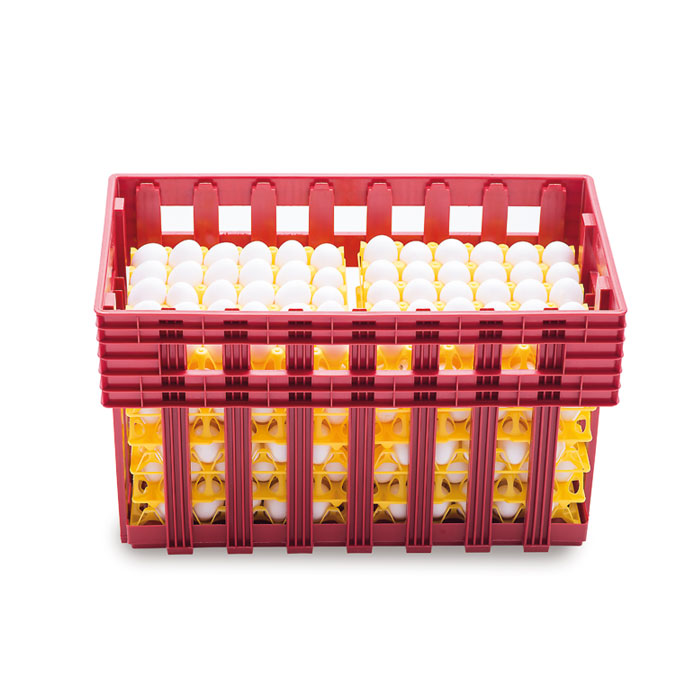
Egg Handling – Egg boxes, Egg Trays and Egg Crates
Ready, Set, Go!
You are ready to get started raising chickens! Now you know how to prepare a coop for backyard chickens, choose a breed, order chicks, feed your birds and keep them healthy. All that’s left is the pleasure of collecting eggs each morning. Find more information on raising urban chickens here.
Trish Sie from the King’s Roost shares what it’s like to raise backyard chickens in Los Angeles. She’s learned how to raise chickens from six years hands-on experience!


